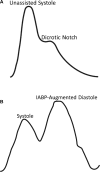Transcranial Doppler Waveforms During Intra-aortic Balloon Pump Counterpulsation for Vasospasm Detection After Subarachnoid Hemorrhage
- PMID: 28973669
- PMCID: PMC6454792
- DOI: 10.1093/neuros/nyx405
Transcranial Doppler Waveforms During Intra-aortic Balloon Pump Counterpulsation for Vasospasm Detection After Subarachnoid Hemorrhage
Abstract
Background: Transcranial Doppler ultrasound is a standard screening tool for vasospasm after subarachnoid hemorrhage. Prevention of vasospasm-induced delayed cerebral ischemia after subarachnoid hemorrhage depends on optimization of cerebral perfusion pressure, which can be challenged by neurogenic stress cardiomyopathy. Intra-aortic balloon pumps have been utilized to augment cerebral perfusion, but they change the transcranial Doppler waveform, altering its interpretability for vasospasm screening.
Objective: To assess the features of the transcranial Doppler waveform that correlate with vasospasm.
Methods: We retrospectively reviewed cases of subarachnoid hemorrhage that underwent same-day transcranial Doppler ultrasound and angiography. Transcranial Doppler waveforms were assessed for mean velocity, peak systolic velocity, balloon pump-augmented diastolic velocity, and a novel feature, "delta velocity" (balloon pump-augmented velocity - systolic velocity). Relationship of flow velocity features to vasospasm was estimated by generalized estimating equation models using a Gaussian distribution and an exchangeable correlation structure.
Results: There were 31 transcranial Doppler and angiography pairings (12 CT angiography/19 digital subtraction angiography) from 4 patients. Fourteen pairings had proximal vasospasm by angiography. Delta velocity was associated with proximal vasospasm (coefficient -6.8 [95% CI -9.8 to -3.8], P < .001). There was no significant correlation with proximal vasospasm for mean velocity (coefficient -13.0 [95% CI -29.3 to 3.4], P = .12), systolic velocity (coefficient -8.7 [95% CI -24.8 to 7.3], P = .29), or balloon pump-augmented velocity (coefficient -15.3 [95% CI -31.3 to 0.71], P = .06).
Conclusion: Delta velocity, a novel transcranial Doppler flow velocity feature, may reflect vasospasm in patients with subarachnoid hemorrhage and intra-aortic balloon pumps.
Figures



Similar articles
-
Symptomatic vasospasm diagnosis after subarachnoid hemorrhage: evaluation of transcranial Doppler ultrasound and cerebral angiography as related to compromised vascular distribution.Crit Care Med. 2002 Jun;30(6):1348-55. doi: 10.1097/00003246-200206000-00035. Crit Care Med. 2002. PMID: 12072693
-
Effect of age on cerebral blood flow velocity and incidence of vasospasm after aneurysmal subarachnoid hemorrhage.Stroke. 2001 Sep;32(9):2005-11. doi: 10.1161/hs0901.094622. Stroke. 2001. PMID: 11546889
-
Difference in Transcranial Doppler Velocity and Patient Age between Proximal and Distal Middle Cerebral Artery Vasospasms after Aneurysmal Subarachnoid Hemorrhage.Cerebrovasc Dis Extra. 2016;6(2):32-9. doi: 10.1159/000447330. Epub 2016 Jul 6. Cerebrovasc Dis Extra. 2016. PMID: 27665361 Free PMC article.
-
Transcranial Doppler ultrasonography in intensive care.Eur J Anaesthesiol Suppl. 2008;42:167-73. doi: 10.1017/S0265021507003341. Eur J Anaesthesiol Suppl. 2008. PMID: 18289437 Review.
-
Intra-aortic balloon pump counterpulsation in the setting of subarachnoid hemorrhage, cerebral vasospasm, and neurogenic stress cardiomyopathy. Case report and review of the literature.Neurocrit Care. 2010 Aug;13(1):101-8. doi: 10.1007/s12028-010-9358-x. Neurocrit Care. 2010. PMID: 20383610 Review.
Cited by
-
Surface Point Cloud Ultrasound with Transcranial Doppler: Coregistration of Surface Point Cloud Ultrasound with Magnetic Resonance Angiography for Improved Reproducibility, Visualization, and Navigation in Transcranial Doppler Ultrasound.J Digit Imaging. 2020 Aug;33(4):930-936. doi: 10.1007/s10278-020-00328-y. J Digit Imaging. 2020. PMID: 32076925 Free PMC article.
References
-
- Frontera JA, Fernandez A, Schmidt JM et al. . Defining vasospasm after subarachnoid hemorrhage: what is the most clinically relevant definition? Stroke. 2009;40(6):1963-1968. - PubMed
-
- Kassell NF, Sasaki T, Colohan AR, Nazar G. Cerebral vasospasm following aneurysmal subarachnoid hemorrhage. Stroke. 1985;16(4):562-572. - PubMed
-
- Kreiter KT, Mayer SA, Howard G et al. . Sample size estimates for clinical trials of vasospasm in subarachnoid hemorrhage. Stroke. 2009;40(7):2362-2367. - PubMed
-
- Kassell NF, Torner JC, Haley EC, Jane JA, Adams HP, Kongable GL. The International Cooperative Study on the Timing of Aneurysm Surgery. Part 1: overall management results. J Neurosurg. 1990;73(1):18-36. - PubMed
-
- Lee VH, Oh JK, Mulvagh SL, Wijdicks EF. Mechanisms in neurogenic stress cardiomyopathy after aneurysmal subarachnoid hemorrhage. Neurocrit Care. 2006;5(3):243-249. - PubMed
MeSH terms
Grants and funding
LinkOut - more resources
Full Text Sources
Other Literature Sources

